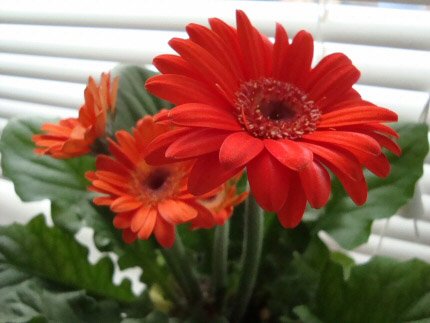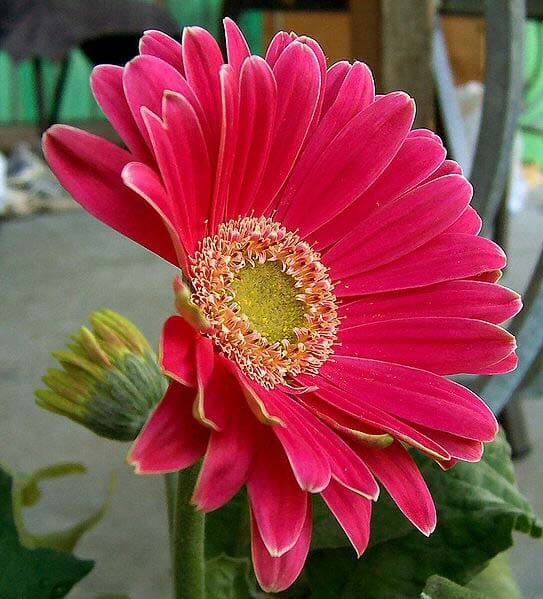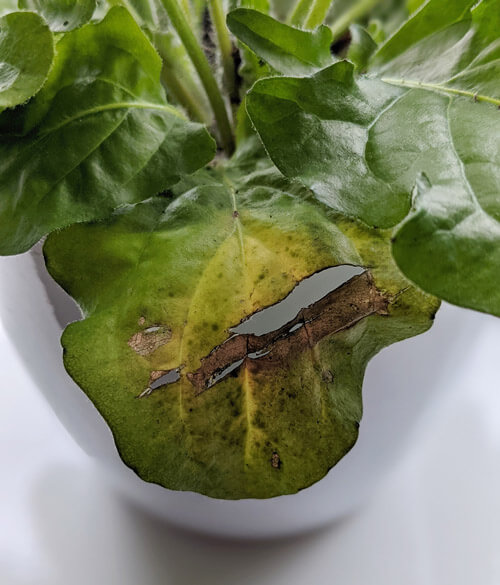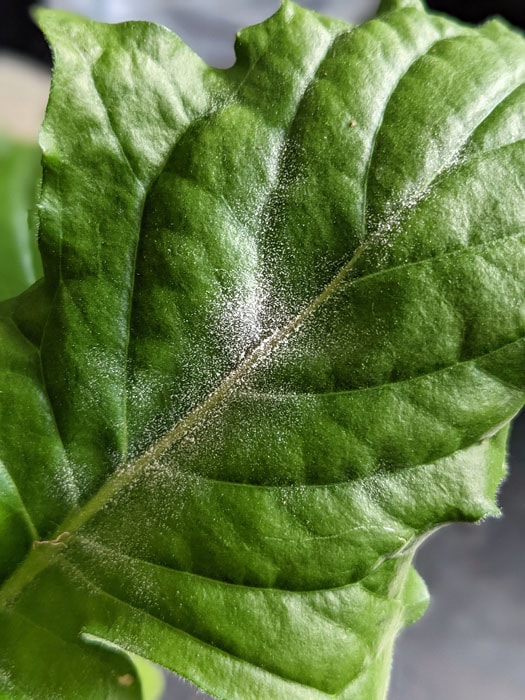The Gerbera or Transvaal Daisy is a houseplant from South Africa that's related to the familiar white and yellow daisies that you find growing outside on the lawn. Except the Gerbera is much bigger, has a variety of different coloured blooms and is one of the most frequently used cut flowers around the world when it comes to flower arranging.
It was given its scientific name of Gerbera Jamesonii in 1889 after the German botanist Traugott Gerber, who was friends with the plant naming expert Carl Linnaeus. It's almost universally known as a Gerbera. No special or clever naming here.
The flowers of Gerbera daisies can be yellow, pink, orange, or as shown here, red.
As for growing it. When grown outdoors it's "easy" but as a houseplant, it becomes "difficult". That said it's still an easy care houseplant for the most part and even if you give it poor care over a prolonged period Gerbera's won't give up on you easily.
The main problem is that this plant is only really wanted when it's flowering. At all other times, it lacks serious attraction and so unless you can find beauty in the very average, almost dandelion-like, looking leaves, it might not be a houseplant you want around for very long if it's not in flower.
Tip - This plant has weed-like leaves. And they're ugly. There we said it. But with good care, you can have your plant blooming almost all year round which distracts from the leaves. They're worth the effort so treat it right.
Here's the good news, with the correct care, it produces new flowers quite profusely. The only "difficult" part therefore is getting the flowers to return and this is because Gerbera's need some sun to produce the colorful flowers. But grown indoors, sunshine or bright light shinning through windows produces a lot of heat which Gerberas struggle with.
Ultimately unless you can meet the care requirements detailed below a Gerbera indoors is often treated like a pot plant. Much like the Poinsettia, Chrysanthemum or Hyacinth. This means you enjoy the blooms for several months before either discarding the plant or transplanting it into the garden.
However if you can provide the necessary bright light along with average temperatures you could potentially have it somewhere in your home all year round because the flowers are produced regularly. If you would like to give it a go at making it a permanent guest we explain more here.
It's a real shame the leaves look so plain, as many houseplants that flower have attractive foliage which gets you through the "bloom droughts". A variety with striking leaves could be a strong selling point, however there are not many (if any) commercially sold cultivars or varieties out there that focus on the leaves. With Gerberas, all eyes are on the blooms.
Gerberas are perennial flowering plants that can easily be grown as indoor plants all year round
These are cheap houseplants to buy and the flowers are very large and long lasting considering their price. If you want some vivid colour to brighten up a space in your home, the Gerbera is a perfect plant to do just that.
Let's take a look at the care guide and what you should be doing to keep your plant healthy and looking cheerful for as long as possible.

Hi, I'm Tom!
If you're like me and enjoy the challenge of growing houseplants and getting them to thrive, then Ourhouseplants can help. This website shares my knowledge and years of growing plants and provides (hopefully) helpful advice on properly caring for your indoor plant friends.
These plants must have good bright light if you expect repeat blooming, but direct harsh sunlight can quickly damage your Gerbera. Intense sun can scorch the leaves and increase the temperature around your plant to very high (and undesirable) levels.
If your intended placement receives full sun for a few hours a day either in the morning or late afternoon this would be perfect. Although newly brought plants might need to be accustom to the change in light level if it was growing somewhere darker, say in a shop without any windows. If you just plonk it down in such a place expect it to go into shock.
Tip - Take care to avoid splashing the leaves, like African Violets it's best to water from the bottom, or around the sides rather than over the leaves, as doing this can encourage various fungal diseases.
The target you're aiming for should be to have moist, rather than dry or soaking wet, soil. Don't re-water a moist plant, wait for the top of the soil to dry out first.
Try to water often in warmer months of the year perhaps once or twice a week. It will depend of course how warm your home is and how much light your plant is getting. Plants grown in cooler and less bright conditions will take longer to dry out and therefore need less water than those in warm and sunny areas.
The humidity you find in most homes is more than sufficient. However avoid very humid places such as bathrooms as this can encourage fungus growth on the leaves and flower buds in the heart of the plant.
Feeding is quite important if you plan to keep your Gerbera as a permanent houseplant. Look for a fertiliser that is high in Potassium (or Potash) such as a tomato feed, to encourage repeat flowering, however you can also make do with a general all purpose formula.
Feeding once a month following the manufacturer's instructions should be plenty. If your Gerbera is flowering and growing in the Winter months (not all will), it's fine to keep providing low-level amounts of feed.
This Gerbera has been well fed and has three orange flowers in bloom at the same time
Cool to average temperatures will keep the plant in bloom for longer and encourage repeat flowering.
13°C (55°F) - 24°C (75°F). The flowers will last a lot longer and you'll increase your chances of repeat blooms in the long run if you try and avoid the maximum temperature and provide closer to the cool temperature.
There is no need to repot if you're only treating the plant as a colorful temporary house guest. The pot it comes in will more than likely be perfectly suitable for six months or so.
If you keep your plant for longer and want to repot it, go for it. Standard commercial potting soil is suitable when you repot. You can do it at any time of the year and the next container should only be slightly bigger than the last. Shock can affect your Gerbera when repotting.
The flowers produce seeds which you can try and germinate in Spring, although they will often not come true, i.e. the new plants might not look the same as their parents.
Tip - It's worth pointing out that almost all Gerbera's are reasonably priced and it's usually more economical to buy yourself a new one instead of propagating.
Buying a new plant will often mean you'll know what colour flowers you're getting. It'll also be fully grown whereas one grown from seed could take up to a year or more to reach flowering stage.
If you've had your plant for a while (or just got lucky when buying it) then you may have a plant that has several crowns.
You can divide these using a sharp knife ensuring each crown has some roots. Remove about a third of the mature lower leaves (leave the new small leaves where they are) and pot up into a similar mix to where it was growing previously.
They should fully re-establish after a month or so and you can reasonably expect new blooms to start forming well within a year.
Green leaf growth is fast when young plants are maturing, but older plants tend to grow a lot slower as they're spending their energy producing new flowers.
As a houseplant Gerberas rarely grow above 60cm / 24in high and "spread" wise you are looking at no more than 45cm / 18in.
Unlike some flowering houseplants, the leaves of the Gerbera are quite dull in appearance, so the eye-grabbing flowers are of great importance to drawn attention away from the leaves.
The large daisy-like blooms rise above the plant on strong stems, typically lasting for several weeks or sometimes longer if temperatures are on the cool side.
Gerbera with vivid pink flowers - photo by Fir0002
The blooms can be singles or doubles and come in many different shades: white, cream, yellow, pink, salmon and red. The flowers can sometimes measure 7 inches or more across. Although when grown as houseplants they tend to be smaller and not normally more than 4 inches across at most.
It's common for several blooms to appear over a period of weeks with more emerging from the center of the plant after the first flush is fading, this prolongs the time it's in flower.
Deadhead (remove) the spent blooms on your Gerbera to stop the plant from spending time and energy producing seeds. This will keep the plant looking tidy and also encourage it to produce more flower buds.
Gerbera plants are safe to have around children and pets as they're not toxic.
Given ideal growing conditions you can expect flowers to appear during Summer months. However if you want to try and get your plant to flower as much as possible throughout the year following these tips:
Bright Light - Avoid intense Sun East and west-facing windows are the ideal choice. South-facing is suitable if there is some sort of shielding in place from the intense midday sun.
Moderate Watering If the light levels are good and the temperature is warm, expect to water once or twice a week. In lower light locations or if the temperature is on the cooler side you'll likely be looking at once every two weeks.
Temperature13°C (55°F) - 24°C (75°F) is the range your plant wants. The flowers will last longer if you avoid the higher temperature range.
Feeding Try to fertilise a little at least once a month.
For most plants this would be a clear sign of underwatering. It could be true here of course, but more often than not, it's caused by shock, due to a sudden shift in climate. If you haven't been moving your plant around and you've been watering correctly then the other possibility is that the temperature has become too high.
In all cases make sure the soil is actually moist, in a cool and non sunny location and then leave the plant alone, within a few days it should have fully recovered.
No flowers
Gerbera's can be brought in flower for much of the year, however if you've had it a while then it will be following its natural growth cycle. Follow our top tips to keep the blooms coming.
Yellow Leaves
It's typical for the oldest leaves to yellow up and die occasionally. Although it's more probable the plant's been overwatered. They love having moist soil, but too much or too frequent watering can cause problems. Leave the top surface of the soil to dry out before you water again.
Yellow leaf problems on a Gerbera plant
Pests
Gerbera's do well resisting most pests, but they can make attractive homes for whitefly. A brush past the leaves releases a cloud of white flying bugs.
You can either spray the leaves with a proprietary insecticide spray, or use an insecticide "spike". You can usually get these from larger garden centers and you basically insert it into the soil like a stick.
Other Leaf problems
Almost all diseases affecting the leaves such as powdery mildew or the fungus botrytis, are caused by either careless watering (splashing the leaves) or having your Gerbera in a very humid place.
Gerbera's in my home suffer more bouts of powdery mildew than all my other houseplants combined
Good watering technique and ventilation are a must to prevent leaf issues. However if you still fall victim you can either remove the infected leaves or spray with a proprietary fungicide.
As a kid, I loved the cheery nature of daisies growing in lawns. At school everyone seemed to pick as many as possible with the longest stems and create mini bouquets to give to fellow classmates or teachers (yeah I was really cool as a kid).
With that in mind, perhaps it's no surprise that the Gerbera, which pretty much looks like a giant daisy, was naturally attractive to me. And with flowers that look like this, who can resist them really?
They tend not to last too long in any home I've lived in (I like it warm, and they prefer it cooler), so their visit tends to be fleeting rather than long term. However I found they make super presents and I love gifting them to family and friends as an alternative to a bunch of flowers or an expensive houseplant that I know the owner just won't be able to keep alive.
If you're looking for a cheap but cheerful indoor plant to brighten up a drab-looking spot, this could well be your go to. Share your experiences with us below.
Credit for the Gerbera with pink flowers - Article / Gallery - Fir0002





